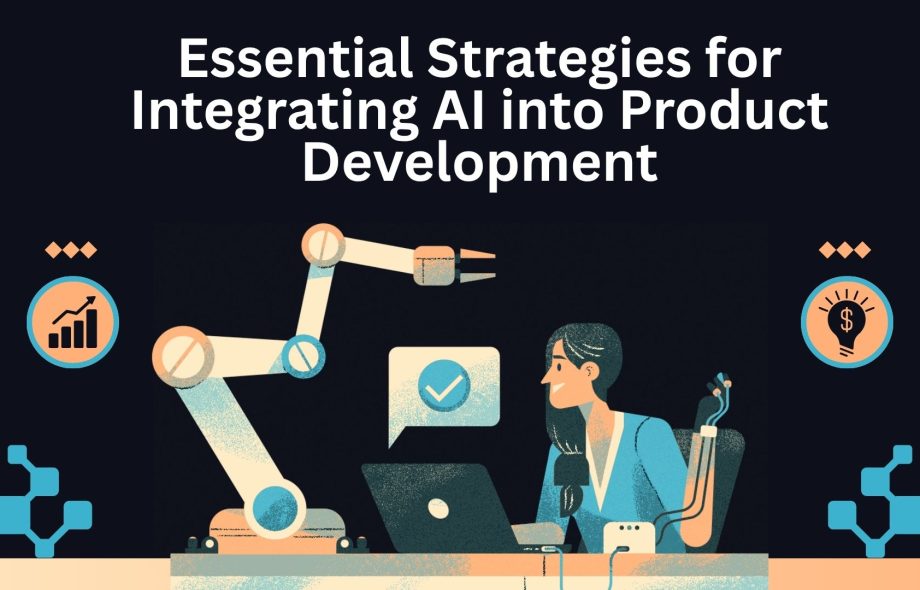Artificial intelligence has shifted from being an experimental technology to a practical catalyst that drives innovation, efficiency, and competitive differentiation. For modern organizations, integrating AI into product development is no longer optional—it’s a strategic imperative. However, successful implementation requires more than just adopting tools. It demands a structured approach, thoughtful planning, and alignment with customer needs. This article explores essential strategies that help organizations seamlessly integrate AI in Product Development lifecycle and unlock measurable value.
1. Start With a Clear AI Vision and Business Goal
The first step in integrating AI into product development is to define a clear strategic vision. Many companies rush into adopting AI because of market pressure, but without a well-defined purpose, such efforts rarely succeed. Businesses must identify:
1. The problems AI is expected to solve
2. The measurable outcomes it should influence
3. The customer experience improvements it should deliver
Instead of jumping into complex AI models, teams should begin by identifying specific use cases such as automated testing, intelligent recommendations, predictive maintenance, or customer behavior modeling. When goals are clear, the entire product development team can make informed decisions that align with organizational priorities.
2. Build High-Quality, Well-Structured Data Pipelines
AI systems are only as powerful as the data that fuels them. Organizations must invest early in building robust data pipelines that ensure clean, structured, and accessible data. This involves:
1. Consolidating data from different internal and external sources
2. Removing duplicates, errors, and inconsistencies
3. Implementing data governance and access controls
4. Ensuring compliance with privacy regulations like GDPR or CCPA
By prioritizing data quality, companies reduce model inaccuracies and ensure AI predictions are reliable. Well-architected data pipelines also accelerate the development process, enabling faster iteration and continuous improvement.
3. Incorporate AI Early in the Product Life Cycle
Integrating AI should not be an afterthought. The earlier AI is considered in the product development lifecycle, the better the outcomes. During ideation, teams should evaluate whether user challenges can be addressed more effectively through AI-driven automation or intelligence. During design, UX specialists should determine how AI insights will appear in the interface. During development and testing, engineers can build machine learning models in parallel with core product features.
1. Embedding AI into early planning ensures:
2. Reduced rework and technical debt
3. Smooth integration with existing systems
4. Better alignment with user needs
5. Optimized time-to-market
Organizations that adopt AI early often innovate faster and create more cohesive, intelligent products.
4. Develop a Cross-Functional AI Team
AI integration is not solely an engineering function. It requires collaborative contributions from data scientists, UX designers, product managers, engineers, and domain experts. A cross-functional team ensures that AI features are not only technically sound but also user-centric and strategically aligned.
Key roles may include:
Data Scientists – Model building and experimentation
Machine Learning Engineers – Deployment and optimization
Product Managers – Strategy and requirement definition
UX Designers – AI-driven experience creation
Subject-Matter Experts – Domain understanding and validation
Strong communication among these roles ensures AI features add meaningful value rather than becoming complex novelties that users do not need.
5. Prioritize Interpretability and Transparency
One of the biggest challenges in AI adoption is trust. Users and stakeholders may hesitate if AI decisions appear opaque. To overcome this, organizations must prioritize transparency. Explainable AI (XAI) methods allow users to understand why a model made a certain decision, which is especially critical in industries like finance, healthcare, and insurance.
Building trust requires:
Clear communication about AI limitations
Visual explanations of model outputs
Providing manual override options where necessary
Ensuring the AI complements human decision-making rather than replacing it
Transparent systems encourage wider adoption and boost user satisfaction.
6. Implement Continuous Monitoring and Improvement
AI models are not static—they evolve with data. Continuous monitoring is essential to ensure model accuracy, performance, and fairness. Over time, user behavior changes, market conditions shift, and new data patterns emerge. Without active monitoring, AI models may become biased or ineffective.
Organizations should set up:
1. Automated model evaluation pipelines
2. Early-warning systems for performance drops
3. Regular retraining schedules
4. Feedback loops from real user data
Continuous improvement ensures AI features remain reliable, relevant, and competitive.
7. Address Ethical and Regulatory Requirements
AI ethics cannot be overlooked. Responsible AI practices reduce risk, protect user trust, and ensure compliance with evolving regulations. Ethical AI implementation requires:
1. Minimizing bias through diversified training datasets
2. Ensuring transparency in decision-making
3. Protecting user data with strong security measures
4. Implementing fairness audits and compliance reviews
Ethical considerations enhance long-term brand value and reduce legal exposure.
8. Scale AI Through Modular Architecture and Automation
To maximize efficiency and scalability, organizations should design modular AI architectures. Containerized deployments, reusable model components, and automated ML pipelines (MLOps) accelerate development and reduce operational overhead. This enables teams to integrate new AI features faster and scale with minimal friction.
1. A strong MLOps foundation includes:
2. Version control for models and datasets
3. Automated deployment workflows
4. Real-time monitoring dashboards
5. Scalable cloud-based training environments
Such systems ensure that AI becomes an integral, sustainable part of product development.
9. Invest in the Right Talent and Partnerships
To fully leverage AI, organizations need skilled talent—whether through internal training, hiring, or partnerships.Hire AI Developersto bring in the right expertise to ensure faster development cycles, stronger model performance, and smoother integration.
Final Thoughts
Integrating AI into product development is a transformative journey that requires strategic planning, cross-functional collaboration, and long-term commitment. By focusing on data quality, transparency, ethical considerations, and continuous improvement, organizations can create intelligent products that meet customer needs and drive sustainable innovation. With the right strategies in place, AI becomes a powerful tool for shaping the future of product development.


 :
: